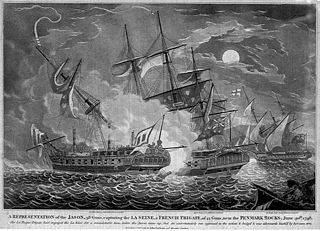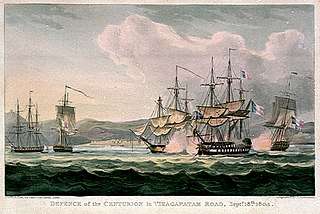HMS Sceptre was a 64-gun third-rate ship of the line of the Royal Navy, launched on 8 June 1781 at Rotherhithe. The ship was wrecked in a hurricane on 5 November 1799 in Table Bay near the Cape of Good Hope.

HMS Glatton was a 56-gun fourth rate of the Royal Navy. Wells & Co. of Blackwell launched her on 29 November 1792 for the British East India Company (EIC) as the East Indiaman Glatton. The Royal Navy bought her in 1795 and converted her into a warship. Glatton was unusual in that for a time she was the only ship-of-the-line that the Royal Navy had armed exclusively with carronades. She served in the North Sea and the Baltic, and as a transport for convicts to Australia. She then returned to naval service in the Mediterranean. After the end of the Napoleonic Wars the Admiralty converted her to a water depot at Sheerness. In 1830 the Admiralty converted Glatton to a breakwater and sank her at Harwich.

Seine was a 38-gun French Seine-class frigate that the Royal Navy captured in 1798 and commissioned as the fifth-rate HMS Seine. On 20 August 1800, Seine captured the French ship Vengeance in a single ship action that would win for her crew the Naval General Service Medal. Seine's career ended in 1803 when she hit a sandbank near the Texel.

HMS Persian was a Cruizer-class brig-sloop built by Daniel List and launched at Cowes in 1809. She captured two privateers before she wrecked in 1813.
HMS Moucheron was a French privateer, built in 1799, that the British captured in 1801. The British government purchased her in 1802 for the Royal Navy. She foundered in 1807 in the Mediterranean without leaving a trace.
Orénoque by one account was a French privateer sloop commissioned in French Guiana in 1781. Another account has her as a Dutch merchant vessel purchased into service. If so, she may have been one of the vessels that some British privateers captured during the raid on Essquinbo and Demerara in late February 1781. The French captured her in 1782 when they captured Demerara; they disposed of her in 1784 or so.

Princess Charlotte was an "extra ship’’ of the British East India Company (EIC), launched in 1796. She made four voyages for the EIC. On her second voyage she suffered a short-lived mutiny and then spent almost a year as an armed ship in the service of the EIC, including a voyage to the Red Sea. A squadron of the French Navy captured her in the Vizagapatam roads in 1804, on her fourth voyage.
HMS Resolution was a cutter that the Royal Navy purchased in 1779. She captured two French privateers in 1781 and a Dutch privateer in 1783 after a single ship action. Resolution captured one more small French privateer in June 1797; later that month Resolution went missing in the North Sea, presumed to have foundered.
Princess Royal, launched in 1786, was an East Indiaman. She made two complete trips to India for the British East India Company (EIC) and was on her third trip, this one to China, when French privateers or warships captured her on 27 September 1793. The French Navy took her into service in the Indian Ocean as a 34-gun frigate under the name Duguay Trouin. The Royal Navy recaptured her and she returned to British merchant service. In 1797 she performed one more voyage for the EIC. She received a letter of marque in July 1798 but was captured in October 1799 off the coast of Sumatra.

HMS Barbuda was commissioned into the Royal Navy in 1780 after having briefly served as an American privateer. Barbuda was one of the two sloops that captured Demerara and Essequibo in 1781, but the French Navy captured her there in 1782 and took her into service as Barboude. The French Navy sold her to private owners in 1786, and she served briefly as a privateer in early 1793 before the French Navy purchased her again and named her Légère. She served them until mid-1796 when the Royal Navy captured her and took her into service as HMS Legere. She was wrecked off the coast of Colombia, without loss of life, in February 1801.
Carron was launched at Bombay Dockyard in July 1792. She was a country ship that made several voyages for the British East India Company (EIC) before the Royal Navy purchased her in 1804 to use as a fifth-rate frigate, and renamed Duncan. In 1807 the Navy renamed her Dover. She was wrecked off Madras on 2 May 1811.
Highland Chief was launched at Calcutta in 1798. She made two voyages for the British East India Company (EIC) before a French privateer captured her in 1802 south of the Bay of Bengal.
Eliza Ann was launched at Calcutta in 1795. She sailed to England where she was admitted to the Registry. In all, she made five voyages for the British East India Company (EIC), during one of which she participated in a notable action and during the last of which she captured a French privateer. She herself was lost in 1807.
Princess of Wales was launched at Stockton in 1795. She made three voyages as an "Extra ship", i.e., under charter, for the British East India Company (EIC). On her return she became a West Indiaman. A privateer captured her in 1803 as she was coming back to England from Jamaica, but British privateers immediately recaptured her. She continued sailing to Jamaica though later, under a new owner, she traded more widely. She probably foundered in 1828, and is last listed in 1830.
Varuna was launched at Calcutta in 1796. She made four voyages as an "extra ship" for the British East India Company (EIC), and then spent two years as a troopship. She returned to India in 1806. She was lost in 1811, probably in a typhoon.
Dublin was launched in 1784 as an East Indiaman. She made six voyages for the British East India Company (EIC), to India and China. On her last voyage for the EIC she recaptured a country ship. Her owners sold Dublin in 1800 and she became a West Indiaman, but apparently was lost on her first voyage.
HMS Utile was the French 16-gun privateer brig-sloop Utile launched in 1799 that the Royal Navy captured in 1799 and took into service; she foundered in the Mediterranean in 1801.

HMS Bonetta was the French privateer Huit Amis, launched at Bordeaux in 1798 that the British Royal Navy captured in May. In her brief naval career she captured a number of small prizes, one of them a 2-gun privateer. Bonetta was wrecked in 1801.
William Pitt was launched on the River Thames in 1785 as an East Indiaman. She made six voyages for the British East India Company (EIC). During her fourth she served as an ad hoc warship in a naval campaign during which she saw action. Thereafter she served as a transport, including one voyage in 1801-1802 transporting rice from Bengal to Britain. She was sold for breaking up in 1809.
The H[onourable] C[ompany's] S[hip] Intrepid was launched in 1780 by the Bombay Dockyard. She was a snow belonging to the British East India Company's naval arm, the Bombay Marine. She participated in the seizure of Malacca on 17 August 1795 and in an inconclusive single-ship action with a French privateer off Muscat on 22 November 1800. She foundered without a trace in late 1800 or early 1801.





